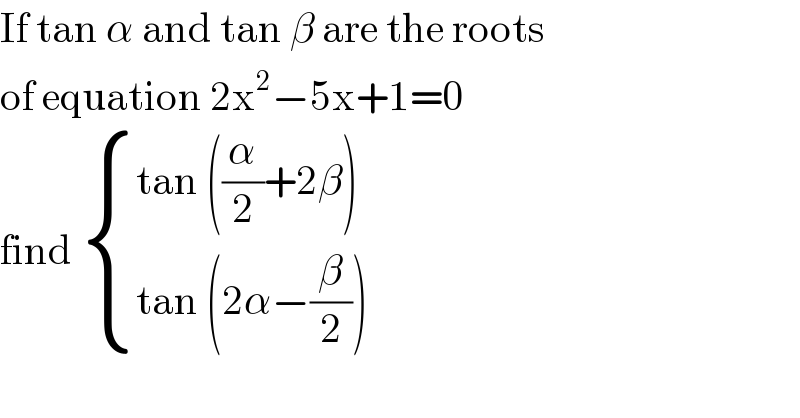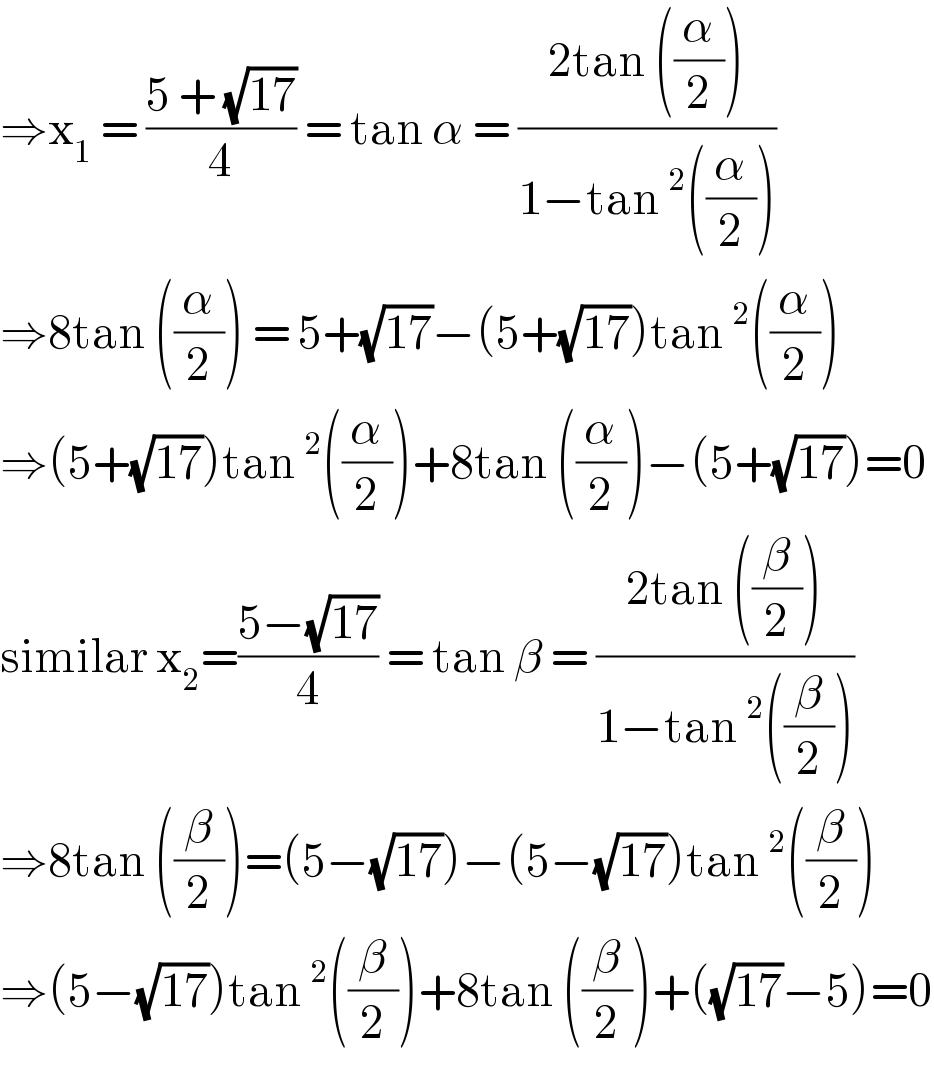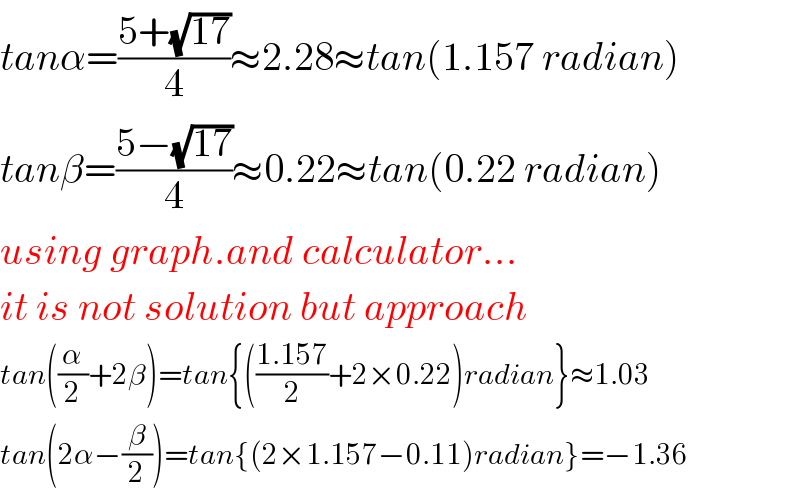
Question Number 116503 by bemath last updated on 04/Oct/20

$$\mathrm{If}\:\mathrm{tan}\:\alpha\:\mathrm{and}\:\mathrm{tan}\:\beta\:\mathrm{are}\:\mathrm{the}\:\mathrm{roots}\: \\ $$$$\mathrm{of}\:\mathrm{equation}\:\mathrm{2x}^{\mathrm{2}} −\mathrm{5x}+\mathrm{1}=\mathrm{0} \\ $$$$\mathrm{find}\:\begin{cases}{\mathrm{tan}\:\left(\frac{\alpha}{\mathrm{2}}+\mathrm{2}\beta\right)}\\{\mathrm{tan}\:\left(\mathrm{2}\alpha−\frac{\beta}{\mathrm{2}}\right)}\end{cases} \\ $$
Answered by bobhans last updated on 04/Oct/20

$$\Rightarrow\mathrm{x}_{\mathrm{1}} \:=\:\frac{\mathrm{5}\:+\:\sqrt{\mathrm{17}}}{\mathrm{4}}\:=\:\mathrm{tan}\:\alpha\:=\:\frac{\mathrm{2tan}\:\left(\frac{\alpha}{\mathrm{2}}\right)}{\mathrm{1}−\mathrm{tan}\:^{\mathrm{2}} \left(\frac{\alpha}{\mathrm{2}}\right)} \\ $$$$\Rightarrow\mathrm{8tan}\:\left(\frac{\alpha}{\mathrm{2}}\right)\:=\:\mathrm{5}+\sqrt{\mathrm{17}}−\left(\mathrm{5}+\sqrt{\mathrm{17}}\right)\mathrm{tan}\:^{\mathrm{2}} \left(\frac{\alpha}{\mathrm{2}}\right) \\ $$$$\Rightarrow\left(\mathrm{5}+\sqrt{\mathrm{17}}\right)\mathrm{tan}\:^{\mathrm{2}} \left(\frac{\alpha}{\mathrm{2}}\right)+\mathrm{8tan}\:\left(\frac{\alpha}{\mathrm{2}}\right)−\left(\mathrm{5}+\sqrt{\mathrm{17}}\right)=\mathrm{0} \\ $$$$\mathrm{similar}\:\mathrm{x}_{\mathrm{2}} =\frac{\mathrm{5}−\sqrt{\mathrm{17}}}{\mathrm{4}}\:=\:\mathrm{tan}\:\beta\:=\:\frac{\mathrm{2tan}\:\left(\frac{\beta}{\mathrm{2}}\right)}{\mathrm{1}−\mathrm{tan}\:^{\mathrm{2}} \left(\frac{\beta}{\mathrm{2}}\right)} \\ $$$$\Rightarrow\mathrm{8tan}\:\left(\frac{\beta}{\mathrm{2}}\right)=\left(\mathrm{5}−\sqrt{\mathrm{17}}\right)−\left(\mathrm{5}−\sqrt{\mathrm{17}}\right)\mathrm{tan}\:^{\mathrm{2}} \left(\frac{\beta}{\mathrm{2}}\right) \\ $$$$\Rightarrow\left(\mathrm{5}−\sqrt{\mathrm{17}}\right)\mathrm{tan}\:^{\mathrm{2}} \left(\frac{\beta}{\mathrm{2}}\right)+\mathrm{8tan}\:\left(\frac{\beta}{\mathrm{2}}\right)+\left(\sqrt{\mathrm{17}}−\mathrm{5}\right)=\mathrm{0} \\ $$
Answered by TANMAY PANACEA last updated on 04/Oct/20

$${tan}\alpha=\frac{\mathrm{5}+\sqrt{\mathrm{17}}}{\mathrm{4}}\approx\mathrm{2}.\mathrm{28}\approx{tan}\left(\mathrm{1}.\mathrm{157}\:{radian}\right) \\ $$$${tan}\beta=\frac{\mathrm{5}−\sqrt{\mathrm{17}}}{\mathrm{4}}\approx\mathrm{0}.\mathrm{22}\approx{tan}\left(\mathrm{0}.\mathrm{22}\:{radian}\right) \\ $$$${using}\:{graph}.{and}\:{calculator}... \\ $$$${it}\:{is}\:{not}\:{solution}\:{but}\:{approach} \\ $$$${tan}\left(\frac{\alpha}{\mathrm{2}}+\mathrm{2}\beta\right)={tan}\left\{\left(\frac{\mathrm{1}.\mathrm{157}}{\mathrm{2}}+\mathrm{2}×\mathrm{0}.\mathrm{22}\right){radian}\right\}\approx\mathrm{1}.\mathrm{03} \\ $$$${tan}\left(\mathrm{2}\alpha−\frac{\beta}{\mathrm{2}}\right)={tan}\left\{\left(\mathrm{2}×\mathrm{1}.\mathrm{157}−\mathrm{0}.\mathrm{11}\right){radian}\right\}=−\mathrm{1}.\mathrm{36} \\ $$
